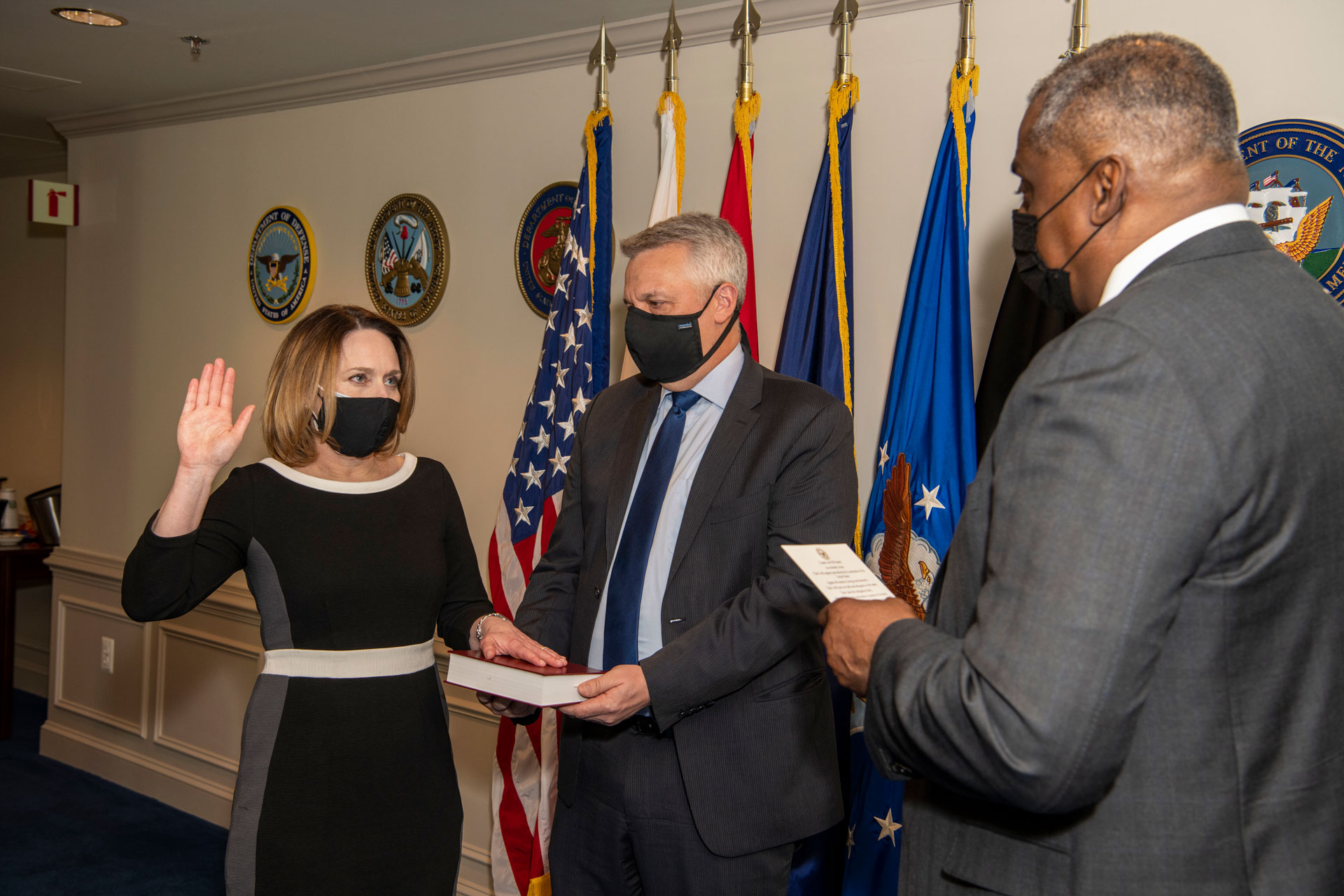
ON THE SCENE: President Joe Biden walks with Secretary of Defense Lloyd J. Austin III, left, Army Gen. Mark A. Milley, chairman of the Joint Chiefs of Staff, center right, and Vice President Kamala Harris at the Pentagon on Feb. 10. (Photo by Lisa Ferdinando, Office of the Secretary of Defense Public Affairs)
Through the change of administration, DOD is expected to keep a steady course.
by Margaret C. Roth
In a transition between presidents who could hardly be a sharper study in political contrast, the outlook for Army acquisition is not one of dramatic change.
Perhaps surprisingly but understandably, given the limited time the Biden administration has to complete the first major step in imprinting its priorities, the federal budget for fiscal 2022, the newly installed DOD leadership is focusing its attention on a few high-visibility initiatives, including the new presidentially driven China Task Force, with the mission of identifying vulnerabilities in the defense industry and U.S. materiel from reliance on Chinese funding and supply; support for the COVID vaccination and prevention effort; and a push to prioritize air and missile defense modernization.
Just when the White House will release the new administration’s first budget has become a political issue in itself. Whatever the date, the defense budget is expected to remain flat under the multitrillion-dollar pressure of the coronavirus pandemic.
U.S. military spending in coming years needs to focus on its preparedness to counter threats from China and Russia, particularly China, Pentagon leadership asserts. In the continuous balancing act of force structure growth, training, equipping and modernization, that means “continued investments in joint force readiness and force modernization, along with accelerated investments in artificial intelligence, machine learning, and other advanced technologies,” according to written testimony submitted by Secretary of Defense Lloyd J. Austin III to the Senate Armed Services Committee as part of the confirmation process. For the Army specifically, it means “continued investments in mobility, logistics and force protection for Ground Combat Teams,” among other priorities.

SECDEF SPEAKS: Secretary of Defense Lloyd J. Austin III participates in a Black History Month virtual engagement on Feb. 26 with high school students from Fort Knox and Fort Campbell, Kentucky, high schools. (Photo by Lisa Ferdinando, Office of the Secretary of Defense Public Affairs)
Across the services, the Pentagon also is likely to continue its “shift in technology development away from traditional acquisition approaches and toward other transaction authority agreements,” according to an analysis by the Center for Strategic and International Studies (CSIS), a prominent Washington think tank, noting the 712 percent increase in defense other-transaction obligations between fiscal years 2015 and 2019. “DOD has shifted toward implementing and understanding the impact of these reforms rather than pursuing additional reform efforts,” states the analysis, “Defense Acquisition in the Biden Administration,” by Rhys McCormick, an associate fellow with CSIS’s Defense-Industrial Initiatives Group.
This shift in direction is likely to continue, McCormick concluded. “In the immediate future, it is more likely that the Biden administration will make incremental improvements and tweaks to the efforts that were started in previous administrations, rather than the wholescale reform seen in recent years,” including expanded efforts in rapid prototyping and experimentation. “The biggest change in priorities between administrations is likely to be how the Biden administration uses the acquisition system to achieve its domestic policy goals, largely focused around Biden’s initiatives to increase ‘Made in America,’ combat climate change, and achieve socioeconomic changes,” McCormick wrote. He noted that DOD accounts for nearly half of all federal acquisitions, and that in the 2019 fiscal year, defense spending on green products totaled $30.8 billion, suggesting that these two major White House initiatives will have significant implications for defense acquisition.

AUSTIN TAKES THE HELM: Thomas Muir, director of Washington Headquarters Services at DOD, swears in Lloyd J. Austin III as secretary of defense at the Pentagon on Jan. 22. Holding the Bible is the junior military assistant to the secretary of defense, Marine Corps Lt. Col. Caleb Hyatt. (Photo by Lisa Ferdinando, Office of the Secretary of Defense Public Affairs)
IN THE LEAD
The Pentagon’s new senior leadership began to take shape immediately after President Joe Biden’s swearing-in as the 46th president of the United States. Secretary of Defense Austin received quick Senate confirmation on Jan. 22 and was sworn in at the Pentagon that same day. A graduate of the United States Military Academy at West Point, Austin served 41 years in uniform, retiring as a four-star general after three years as commander of U.S. Central Command.
Deputy Secretary of Defense Kathleen H. Hicks was confirmed Feb. 8 and sworn in the next day. Hicks comes to the deputy secretary’s job after serving as the senior vice president and Henry A. Kissinger Chair at CSIS. She served in Defense Department policy offices during the Obama administration, including as principal deputy undersecretary of defense for policy and deputy undersecretary of defense for strategy, plans and forces.
As DOD’s de facto chief operating officer, Hicks bears the frontline responsibility of translating strategy into day-to-day programming and budgeting, modernization and reform.
Just who the permanent leadership will be in Army acquisition was not certain as this issue of Army AL&T went to press. President Biden had not yet sent nominations to the Senate for the positions of assistant secretary of the Army for acquisition, logistics and technology (ASA(ALT)) or undersecretary of defense for acquisition and sustainment. Nor had he n a secretary or undersecretary of the Army. But his transition team had named interim officials to fill key posts, including many in acquisition, as of Jan. 20. (See sidebar, “Keeping the Gears Going.”)
“This transition team was really focused on having people in place on day one that didn’t require confirmation,” said Terry Gerton, president and CEO of the National Academy of Public Administration, in a discussion of the transition process Jan. 24 on the news program “Government Matters.” “So they’re already up and rolling inside those departments and agencies.”
Lt. Gen. Robert L. Marion, principal military deputy to the ASA(ALT), took on the additional duties of the ASA(ALT) and principal deputy to the ASA(ALT) on an acting basis, while Rebecca E. Weirick, the deputy assistant secretary of the Army (DASA) for procurement, assumed the duties of Army acquisition executive as well. Brig. Gen. Anthony Potts, program executive officer for Soldier, temporarily took on the duties of principal military deputy to the ASA(ALT).
Since then, a new principal deputy has joined the ASA(ALT) team, as of March 8: Douglas R. Bush, a graduate of West Point who has served in a variety of staff positions on Capitol Hill. As of this writing, he serves as acting ASA(ALT) and the official performing the duties of the Army acquisition executive.
All six DASAs, the deputy for acquisition and systems management, the chief systems engineer and chief technology officer remain in those jobs.
| KEEPING THE GEARS GOING
These are the transition team members the Biden administration has placed in senior Army and acquisition-related positions. All of those at the assistant secretary level and higher would need Senate confirmation to assume permanent status. As of Army AL&T’s publication date, appointees requiring Senate confirmation have not been announced. · Undersecretary of defense for acquisition and sustainment (acting): Stacy A. Cummings, principal deputy assistant secretary of defense for acquisition. · Assistant secretary of defense for acquisition (acting): Dyke Weatherington, deputy assistant secretary of defense for strategic, space and intelligence systems. · Assistant secretary of defense for sustainment (acting): Paul Cramer, principal deputy assistant secretary of defense for sustainment (installations). · Secretary of the Army (acting): John Whitley, assistant secretary of the Army (financial management and comptroller). · Undersecretary of the Army (acting): Christopher Lowman, assistant deputy chief of staff, G-3/5/7; formerly deputy assistant secretary of the Army (DASA) for acquisition policy and logistics and then acting principal deputy ASA(ALT). · ASA(ALT) (acting): Douglas R. Bush, who also is the official serving in the capacity of the Army acquisition executive.
|
NO SHARP TURNS
Judging from the responses that Austin and Hicks gave to policy questions put to them as part of the Senate confirmation process, the Pentagon for which they are now responsible is fully intent on continuing progress made by the previous administrations in modernization of materiel; creative use of the expanded variety of acquisition approaches Congress has made available to program managers in recent years’ defense authorization acts—other-transaction, mid-tier acquisition, Section 2373 authority (to purchase experimental supplies necessary for experimental or test purposes) and others—and management of human capital to match the right talent to the right task at the right time.
Asked for his perspective on the new Adaptive Acquisition Framework that has evolved from new tools authorized by Congress, Austin replied in written testimony to the Senate Armed Services Committee that “the Adaptive Acquisition Framework implements the following tenets: (a) Empower program managers (PMs); (b) Simplify acquisition policy; (c) Employ tailored acquisition approaches; (d) Conduct data driven analysis; (e) Actively manage risk; and (f) Emphasize product support and sustainment,” all objectives Austin pledged to support.
Furthermore, he stated that DOD needs to go further, taking advantage of rapid prototyping and expanded access to new partners in industry, to field new capabilities faster and develop more nontraditional partners with prospects for new defense capability. In particular, Austin told the Senate committee, “Acquisition of services and software remain challenging and implementing sound cybersecurity throughout the acquisition system and the weapon systems it produces is a major need. … In implementing these important authorities, we must balance the absolute need to secure our systems with the impact to cost, schedule and performance in implementing these measures.”
Another top priority for Austin in acquisition is developing the acquisition workforce, he said. That includes tackling what he called the “technical and cultural challenge” of risk management—working with acquisition and sustainment and research and engineering leadership in the Office of the Secretary of Defense and in the military services “to ensure risk is understood and that the acquisition workforce is encouraged to manage risk effectively.”
Asked where responsibility would fall for ensuring that acquisition programs deliver promised capabilities to the end user on time and on budget, Austin responded that he would rely on a collaborative relationship of the secretary of defense, the undersecretary of defense for acquisition and sustainment, the service acquisition executives and the undersecretary of defense for research and engineering and would himself bear ultimate responsibility.
“Problems with acquisition can arise from many factors, including overly ambitious requirements, immature technologies, and poor planning and/or execution by government or contractor teams. … When there are failures, we should learn from them, identify root causes, and move on from the program if a better alternative can be identified.”
On the issue of unrealistic, unfeasible, unstable and unaffordable requirements, Austin was asked what best practices the department can employ to generate realistic and feasible requirements, particularly in sophisticated, rapidly evolving technical areas, and given that software increasingly defines the capability.
“Dynamic approaches to requirements generation in a mission engineering context, as well as insights from prototypes, experiments and pilots aligned with the department’s modernization priorities and the National Defense Strategy, should continuously shape requirements and designs,” Austin stated. He singled out “these approaches that actively engage users, and allow rapid iterative insertion of emerging technologies.”

HICKS SWORN IN: Secretary of Defense Lloyd J. Austin III, right, swears in Dr. Kathleen H. Hicks as deputy secretary of defense on Feb. 9 at the Pentagon. (Photo by Staff Sgt. Jack Sanders, U.S. Air Force)
CONCLUSION
While some think of the presidential transition period as the first 100 days or so, it’s really just the beginning, said Loren Dejonge Schulman, vice president of research at the Partnership for Public Service, in a discussion with Terry Gerton, president and CEO of the National Academy of Public Administration, on “Government Matters.”
“Realistically, transition will go on for the rest of the year,” Schulman said. Historically, it has taken at least this long to get all the appointees in place.
MARGARET C. ROTH is an editor of Army AL&T magazine. She has more than a decade of experience in writing about the Army and more than three decades’ experience in journalism and public relations. Roth is a MG Keith L. Ware Public Affairs Award winner and a co-author of the book “Operation Just Cause: The Storming of Panama.” She holds a B.A. in Russian language and linguistics from the University of Virginia.
Read the full article in the Spring 2021 issue of Army AL&T magazine.
Subscribe to Army AL&T – the premier source of Army acquisition news and information.
![]()







